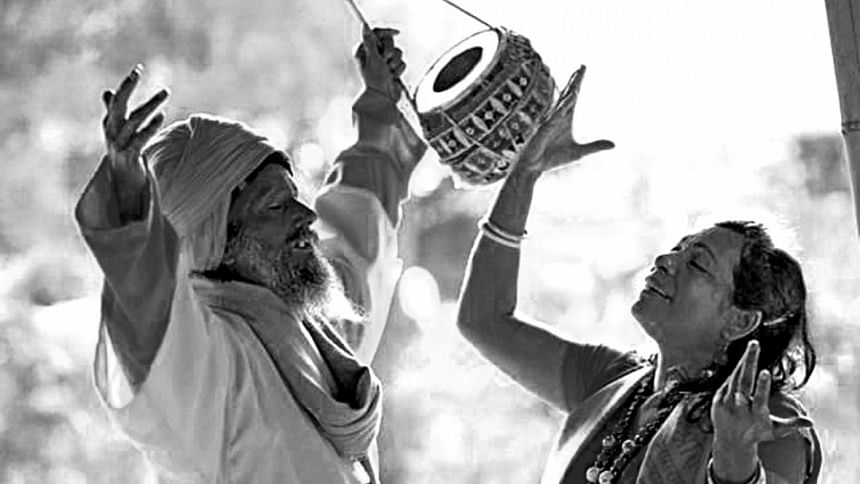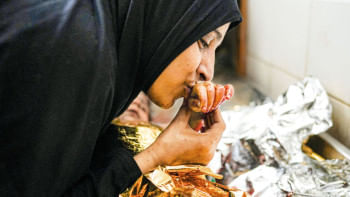Baul Lingoes: An Enigma

Baul songs, stuffed with enigmas and codes, sum up the existential philosophy of deha tatta (Truth in the Body), probably the central theme of Baulism, outlining the aphoristic concept according to which 'whatever is in the universe is in the receptacle (the body).' Bauls hold the view that the body is the microcosm of the universe, and since everything is contained within it all worships should be centered round the body. Like snails, they have a nature of coiling things within themselves. They do not like to let others know about their sacred whispers, objectives and rituals related to their worship. The techniques associated with their austere devotion, their regrets, suggestions, beliefs as well as their heartfelt appeal and surrender to the Creator are expressed in special terms. Except these Bauls themselves who have extensive knowledge of fluid-gnosis, it is very difficult for others to realize the meanings of their lingo. Not only did they use their own terminology, they also assimilated lingoes from the Buddhist, Hindu, Sufi and Vaisnab sadhaks. They have veiled the words of their meditation under various images and symbols. Therefore, to understand an andro-centric Baul song, conscious efforts should be made to decode it which is filled with riddles, using imagery from daily life-activities, such as fishing, farming, sailing, trade and even robbery, foreclosure, and litigation as spiritual metaphors.
Bauls, like tantrics, locate cities, mountains, rivers, pilgrimage places, virtually everything on the map in the human body. Like other tantric yogic practitioners, they conceive of the body as having two forms: the first form is the material or gross body (sthula sarira) made up of the skeleton, muscles, organs, etc., which has nine or ten openings or doors which are ears (2) nostrils(2), eyes (2), mouth(1) anus(1) and sexual organ(1). In the Baul tradition, the tenth door may refer to the female sexual organ or to a lotus with two petals located between the eyebrows. The second form is also an invisible subtle body, called suksma sarfra. The Baul conception of the subtle body for the most part resembles that of the Hindu tantras and of other yogic texts. They adopted it from the Hindu tantras - the system of chakras (centers) arranged along the spinal column from the perineum to the top of the head. These chakras are visualized as lotuses of varying number of petals and are often referred to in Baul songs by the number of petals.
The seven principal chakras in an ascending order are as follows: the muladhar chakra at the base of the spinal column, with four petals; the svadhisthan chakra in the region of the genitals, with six petals; the manipur chakra at the level of the navel, with ten petals; the anahata chakra at the level of the heart, with twelve petals; the visuddha chakra in the region of the throat, with sixteen petals; the ajna chakra between the eyebrows, with two petals; and the sahasrar chakra at the top of the head or above the head, with a thousand petals. Muslim Bauls also describe the body in terms of mokams (Arabic maqamat), "stations" or "stages." The Sufis of Bengal equate the four mokams with the muladhar, manipur, ajna, and anahata chakras. In addition, they include another mokam, the la mokam, equivalent to the sahasrar or ajna chakra. La mokam, literally meaning "no place," is termed so because it represents the transcendent space where all dualities are reintegrated into the Supreme.
The subtle body contains a network of numerous channels or naps that serve as conduits for breath. As in Hindu and Buddhist tantrism, three naps are of prime importance in sadhana. Bauls refer to them by the Hindu tantric terms ira, pingala, and susumna: The ira is on the left of the spinal column, the pingala on the right, and the susumna is in the middle. These naps are identified with the holy rivers Ganga, Yamuna, and Sarasvati. The place where they come together in the muladhar chakra is named the Triveni which is an important locus in sadhana.
The aim of the Baul sadhana is to reverse the cosmic process, which is to return to the Sahaj state - the original condition of non-duality that existed before creation. Male and female principles, Puruja and Prakrti or Sakti, are contained within the microcosmic body of each person, mirroring the macrocosm. The male principle, equated with semen, resides at the top of the head in the highest chakra, the Sahasrar. Here the Supreme exists in a state of perfect unity without any tangible qualities or form; here He is the Atal Ishwar (the motionless Lord). Since in the Sahasrar everything is integrated into the motionless Lord, there is no duality between the enjoyer and the enjoyed, between God and the devotee. For the sadhana to be successful, it is necessary to bring under control the six enemies (lust, anger, greed, infatuation, vanity, and envy) and the ten sense organs (the five organs of perception and the five organs of action). Unbridled lust (kama) personified by the god Kama (also called Madan) is man's worst enemy. In order to affect the transformation of lust (kama) into true love, Prema, the male practitioner, imagines himself as a woman. By "becoming a woman," it is felt his union with a woman will no longer be motivated by desire for physical pleasure. The active form of the Supreme, called the Sahaj Manush or Adhor Manush becomes manifest in the lowest Chakra i.e. the Muladhar, during a woman's menstrual period. It is at this time that the Bauls perform their sadhana to "catch" Him.
Sexuality plays an important part in the Baul search for Adhor Manush, the ultimate truth. Like the tantrics, Bauls believe that the means to experience divine love is through the union of the physical forms of man and woman.
Bauls call the divinity by a number of names, reflecting their eclecticism, such as Allah and Ahad ("the One"), Krishna, Man of the Heart. The other names of the divinity are : Uncatchable Moon, Unknown Man, Natural Man (Sahaj Manus), Uncatchable Man, Golden Friend, Unknown Bird, or simply Lord (Shai).
Whatever ways the divinity has been expressed, the intentional use of enigmatic language, however, poses an impediment to common understanding. Besides, the language of their songs is intended to veil their ritual significance from the unskilled who would find these esoteric practices rather objectionable, and at the same time to reveal to the initiated the ineffable truth which defies logic and cannot be communicated directly through ordinary discourse. And they have made their approaches towards meditation somewhat discreet for quite a few definite reasons: the prohibition of the Guru, a fear of their core ideas being misunderstood, a disbelief in the common comprehension where the efficacy of their practices of ascetic austerities might disappear, and the controversy they might engender meditating on female sexuality.
Paradoxes in Baul songs, thus, are of two types: those that do not seem to have any esoteric significance other than hinting at the ineffable and paradoxical nature of the non-dual Sahaj state, and those that when decoded yield a hidden meaning alluding to secret doctrines. And although at times, they may sound vague, their simplicity, vigor and felicity of expression that apply to a specific religious context as well as to everyday life make them some of the best poetry ever composed in the entirety of Bangla literature.
Haroonuzzaman, a novelist, an essayist and a translator, teaches English at Independent University, Bangladesh (IUB).

 For all latest news, follow The Daily Star's Google News channel.
For all latest news, follow The Daily Star's Google News channel. 



Comments